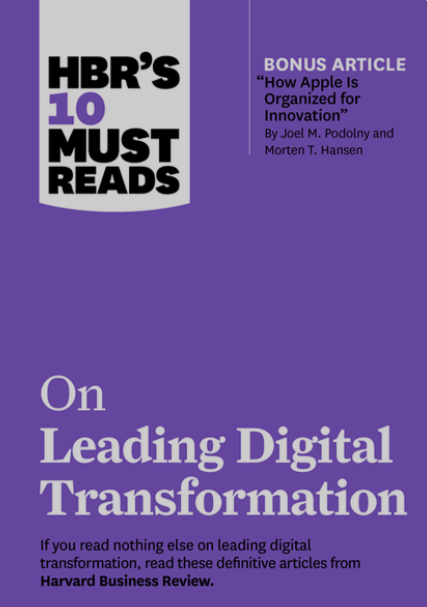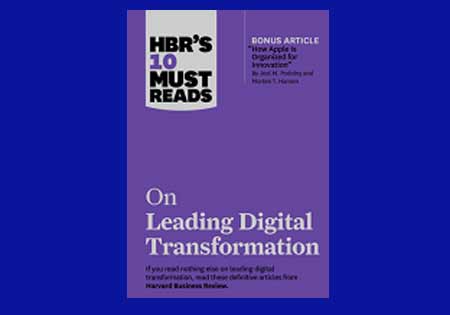
“Technology is the engine of digital transformation, data is the fuel, the process is the guidance system, and organizational change capability is the landing gear”
Whether it’s an aeroplane, a ship, or a shipping company, digital transformation is upon us. Those of us who miss the bus, or don’t adapt properly, may not get another chance. Harvard Business Review compiles a pretty good collection of essays on the various aspects of leading digital transformation. These are high-level or bird’s eye view type articles that inform us on various strategies that could be adopted to make our organisations lean, mean and customer friendly.
Digital transformation requires talent. Leaders need to assemble the right team of people in four domains—technology, data, process, and organizational change capacity. Collaborate to deepen the talent pool teaming up with other companies in the same industry or region to identify relevant skills, invest in developing curricula, and provide on-the-job training. Don’t just set up training programs—create a learning culture continuous-learning model with online and off-line courses and learning on the job through project staffing and team rotations. The authors share their research insights that contrary to popular opinion, employees perceive technology such as AI as instruments to bring about better wages and more interesting and meaningful jobs, and are not necessarily afraid to embrace it, but require that leaders support them in training and showing the way forward.
In terms of strategy, digital transformation can and should be focused on problems of greatest need to the company. There is no one-size-fits-all approach. Traditional shipping companies are better off taking a more incremental approach to transformation over time. Digital doesn’t have to be disruptive. While they should always have a vision of where they want to go, they should work their way toward it by continually finding opportunities to digitize problematic processes in their core operations. Look for problems to fix with digital technology, but exploit your rich knowledge of customers, broad operational scope, and deep talent pools while learning your way to a new business model. But whatever the goal is, it should frame the technology as an opportunity for the business rather than frame the business as an opportunity for the technology. Identify metrics that are more closely linked to the specific improvements you hope digital initiatives will bring about. The idea is that successful technology investments should let you accomplish more with fewer people.
In terms of technology, the development of sensors is allowing cheaper and broader data capture. Then, big data, artificial intelligence, and machine learning are enabling companies to turn enormous amounts of unstructured data into rules and decisions. Connected devices (IoT) and cloud technology are permitting decentralized and widespread data manipulation and analysis. Developments in manufacturing (nanotechnology and 3-D printing) are creating more possibilities for distributed and small-scale production. For example, an algorithm that predicts maintenance would be accompanied by an overhaul of maintenance workflows. A preventive maintenance alert helps the engineer understand the problem before the visit and arrive with the right equipment to fix it. This seamless integration of physical and digital can significantly reduce visits- and I can see this already happening with ECDIS vendors and would like to see more of it from radar, GMDSS, main engine, and auxiliary engine makers.
However, companies also need a data strategy. Cross-industry studies show that on average, less than half of an organization’s structured data is actively used in making decisions - and less than 1% of its unstructured data is analysed or used at all. More than 70% of employees have access to data they should not, and 80% of analysts’ time is spent simply discovering and preparing data. A data management officer is going to be a mandatory position in the organization chart.
Data defence is about minimizing downside risk. Activities include ensuring compliance with regulations (such as rules governing data privacy and the integrity of financial reports), using analytics to detect and limit fraud, and building systems to prevent theft. Defensive efforts also ensure the integrity of data flowing through a company’s internal systems by identifying, standardizing, and governing authoritative data sources, such as fundamental customer and supplier information or sales data, in a “single source of truth (SSOT).” That is not going to happen with multiple excel files flying around as I’ve seen in many organizations.
Data offence focuses on supporting business objectives such as increasing revenue, profitability, and customer satisfaction. It typically includes activities that generate customer insights (data analysis and modelling, for example) or integrate disparate customer and market data to support managerial decision making through, for instance, interactive dashboards.
AI. In traditional operating models, the economy of scale inevitably reaches a point at which it delivers diminishing returns. With AI-driven models, in which the return on the scale can continue to climb to previously unheard-of levels. Wow! The four components of AI are (a) the data pipeline, the semiautomated process that gathers, cleans, integrates, and safeguards data in a systematic, sustainable, and scalable way; (ii) algorithms, which generate predictions about future states or actions of the business; (iii) an experimentation platform, on which hypotheses regarding new algorithms are tested to ensure that their suggestions are having the intended effect; and (iv) infrastructure, the systems that embed this process in software and connect it to internal and external users.
However, only 8% of firms engage in core practices that support widespread AI adoption. One of the biggest mistakes leaders make is to view AI as a plug-and-play technology with immediate returns. Deciding to get a few projects up and running, they begin investing millions in data infrastructure, AI software tools, data expertise, and model development. But then months or years pass without bringing the big wins executives expected. Traditional mindsets and ways of working run counter to those needed for AI. AI has the biggest impact when it’s developed by cross-functional teams with a mix of skills. People at all levels have to trust the algorithms’ suggestions and feel empowered to make decisions—and that means abandoning the traditional top-down approach. If employees have to consult a higher-up before taking action, that will inhibit the use of AI. Most AI transformations take 18 to 36 months to complete, with some taking as long as five years, and effective implementation would be assisted by an internal AI academy.
The book also covers other digital ecosystems like digital twin and augmented reality- all of which have applications in the maritime industry.
Amazon link for the book
Podcast episodes on digitalization in the maritime industry: Daniel Jacobsen
Full disclosure: I don't get paid to post reviews, so you can be assured that this is my candid opinion, and how I see the contents of the book apply to my world. This is part of my effort to bring free-of-cost insights to my colleagues and friends in the maritime industry.


